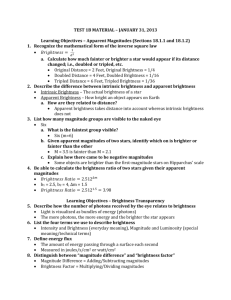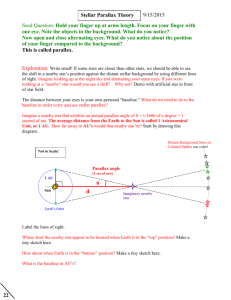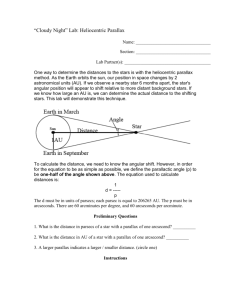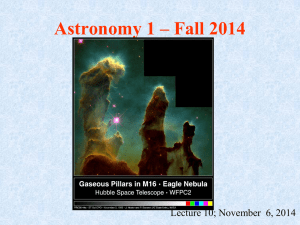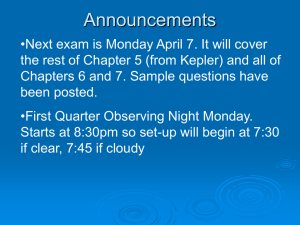Lecture 6
advertisement
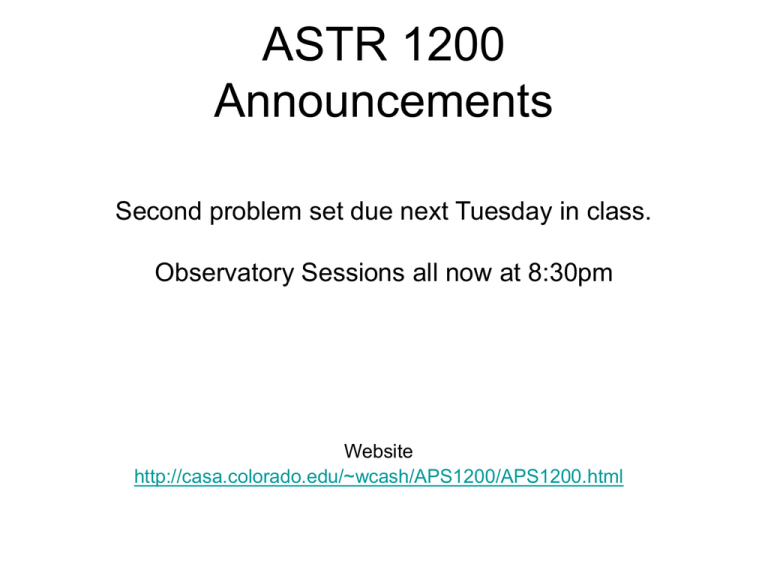
ASTR 1200 Announcements Second problem set due next Tuesday in class. Observatory Sessions all now at 8:30pm Website http://casa.colorado.edu/~wcash/APS1200/APS1200.html Solar Structure Magnetic Fields • Stronger when closer together • Charged particles follow field lines • Magnetic field holds energy Solar Magnetic Fields Sunspots Erupt in Groups Solar Granules • https://www.youtube.com/watch?v=Ekeys TGSdi4 Solar Atmosphere Solar Wind 5x105K Corona 2x106K Transition Region 105K Chromosphere 104K Photosphere 5500K Solar Wind Passes Earth Solar Wind Passes Earth Coronal Mass Ejection Differential Rotation Rotates in 25 days at Equator 28 days Mid Latitude 30 days Poles Rapidly Twists Up Sunspot Cycle During mid 1600’s sunspots became non-existent Maunder Minimum Summary: Sun as a Star • Formed from cloud 4.6x109 years ago • Collapsed to present size – stabilized by nuclear reactions • • • • • • • Emits 4x1026 W Runs on proton-proton chain and CNO cycle Now 20% brighter Turbulent upper envelope Magnetic Fields from Differential Rotation Sunspots, Corona, Solar Wind Activity Cycle 11 years STARS Stars are grouped in Galaxies • Sun and all the stars we see are part of Milky Way Galaxy • Contains 1011 (100 billion) stars You are here 20 • Sun is 3x10 m from center of MW Each star orbits center Disk Stability Again Each Star Orbits the Center How Long does that Take? r3 Orbital Period: P 2π GM r = 3x1020 m, M = 2x1042 kg, G = 6.7x10-11 m3 kg-1 s-2 P 6.28 3x10 20 3 6.7 x1011 x2 x1042 15 8 P 3x10 s 10 yr Takes about a hundred million years to circumnavigate the galaxy Star Names • Arabic Names – Antares, Capella, Mira, etc. • Constellations a Orionis, b Cygni, … then 49 Ori, 50 Ori, etc. • Catalogues HD80591, SAO 733421, etc • RA and Dec – just position in the sky Distances to the Stars • Closest Star, Proxima Centauri is 4x1016m away. (Alpha Cen ~4.3x1016m) • Need a more convenient unit The Light Year • Speed of light is constant • c = 3x108 m/s (300 million meters/second) • Measure distance by how long it takes light to travel The Light Year • Earth circumference: 0.13 light seconds • Distance to Sun: 8 light minutes • Distance to Pluto: 5.5 light hours The Light Year • One year is 3.15x107 seconds long • In one year light travels (3.15x107 s) x (3x108 m/s) = 1016m • This is the definition of a light year. • Proxima Centauri is at 4ly. Parallax • How to measure the distance to stars? • Look at how they appear to move relative to each other Parallax I year cycle The Parsec Parsec (pc) ---- parallax second 1 parsec 1AU 1′′ 360 degrees (360°) in circle 60 arcminutes (60′) per degree 60 arcseconds (60′′) per arcminute Measure Parallax • Distance in parsecs = 1/(parallax in arcseconds) • If parallax is .04′′: d = 1/0.04 = 25 pc • 1 pc = 3x1016 m = 3.3 ly • Measuring Parallax was first successful way to measure distances to stars after centuries of trying Question • Based on the definition of a parsec , if star A has a parallax of 0.5 arcseconds and star B has a parallax of 0.75 arcseconds which one is farther from the Earth? • A. Star B is farther away because it has a higher parallax • B. Star A is farther away because it has a lower parallax • C. All stars are the same distance away from the Earth • D. It is impossible to tell from this information. Question • Based on the definition of a parsec , if star A has a parallax of 0.5 arcseconds and star B has a parallax of 0.75 arcseconds which one is farther from the Earth? • A. Star B is farther away because it has a higher parallax • B. Star A is farther away because it has a lower parallax • C. All stars are the same distance away from the Earth • D. It is impossible to tell from this information. Gaia • Parallax for a billion stars • Distances out to 104 ly • Launched Dec 2013 Proper Motion 2003 All stars move Nearby stars appear to move faster 1900 Appear to move against fixed field Can take many years Use old photographic plates Brightness Around the sky stars vary in brightness and in color. Brightness is the result of two factors 1. Intrinsic Luminosity 2. Distance r Each Sphere has area A=4πr2 Brightness is Star Emits N photons per second B N 4πr 2 photons/m2/s Question If the distance between Earth and the Sun were cut in half, how much brighter would the sun appear in our sky? a.2x brighter b.4x brighter c.8x brighter d.16x brighter Question If the distance between Earth and the Sun were cut in half, how much brighter would the sun appear in our sky? a. 2x brighter b. 4x brighter c. 8x brighter d. 16x brighter Brightness is a function of the inverse square of distance, so if distance was cut by half it would get brighter by 4x=1/(.5)2 Brightness Brightness e.g. 10-12 Watts/m2 Simple and easy to understand If your eye is 10-4m2, then it collects 10-16W 4 stars at 10-12W/m2 together have 4x10-12W/m2 But this would be too easy for astronomers. We use a brightness system invented by Ptolemy in the 400’s The Magnitude System Ptolemy Broke Stars into 5 magnitude groups m=1 the brightest, m=5 the faintest In 1700’s it was found this was a logarithmic scale, as that is how the naked eye responds. Also, faintest were about 100x fainter than brightest. Break the factor of 100 into 5 equal factors: Start with Vega Polaris 2.51x fainter 2.5x fainter than Polaris 2.5x fainter than that etc m=1 m=2 m=3 m=4 1mag 5 100 2.51 Magnitudes (2) Every 5 magnitudes is a factor of 100 m=5 is 100 times fainter than m=0 m=10 is 100x100 =10,000 times fainter than m=0 m=15 is (100)3 = 1million times fainter than m=0 Sun m=-26.5 Full Moon m=-13 Venus m=-4 Sirius m=-1.5 Vega m=1 Polaris m=2 Faintest Visible m=6 Faintest Detected m=28 Works only in the visible. Really inconvenient in modern astronomy because we observe across the spectrum from radio to gamma rays. Absolute Magnitude The magnitude a star would have were it at 10pc We see a star of magnitude m=10 at 100 pc. What would be its magnitude (M) if it were at 10 pc instead of 100pc? At 10 times closer the star would be 100x brighter = 5 magnitudes M = 10-5 = 5 M m 5 log10 d 5 M 10 5 log100 5 10 10 5 5

